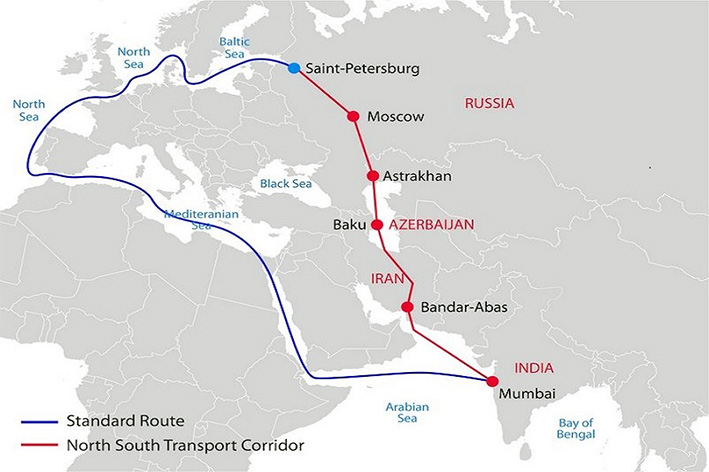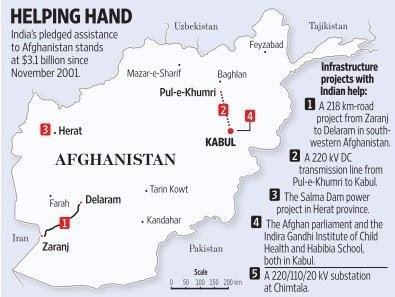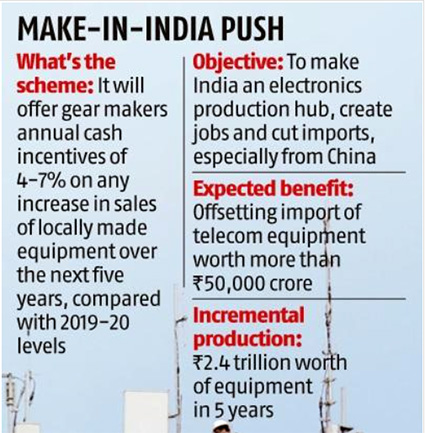International Relations
Push for Chabahar Port in INSTC Corridor
Why in News
India expressed its intent to include Chabahar port in the 13-nation International North South Transport Corridor (INSTC) that extends from India to Russia, and to expand INSTC membership by including Afghanistan and Uzbekistan, at a “Chabahar Day” event organised as part of Maritime India summit.
- This Summit saw participation from several regional officials including infrastructure Ministers from Afghanistan, Armenia, Iran, Kazakhstan, Russia and Uzbekistan.
Key Points
- About India’s Proposal:
- Pitching for Chabahar in the INSTC which goes via Iran’s biggest port Bandar Abbas, India proposed that the land route via Kabul (Afghanistan) and Tashkent (Uzbekistan) would form the INSTC’s “Eastern corridor”.
- India’s push to include Chabahar in the INSTC could have been made with an eye on the new Biden administration’s push for restoring talks with Iran on the JCPOA nuclear agreement, and the possible easing of some sanctions.
- Establishing an eastern corridor through Afghanistan would maximise its potential.
- India highlighted Chabahar’s role in recent years in sending Indian humanitarian aid and emergency supplies to Afghanistan and Iran and in opening up trade opportunities.
- Pitching for Chabahar in the INSTC which goes via Iran’s biggest port Bandar Abbas, India proposed that the land route via Kabul (Afghanistan) and Tashkent (Uzbekistan) would form the INSTC’s “Eastern corridor”.
- Chabahar Port:
- Location:
- It is located on the Gulf of Oman and is only 72 km away from the Gwadar port in Pakistan which has been developed by China.
- About:
- It is the only Iranian port with direct access to the Indian ocean and consists of two separate ports named Shahid Beheshti and Shahid Kalantari.
- Afghanistan, Iran and India signed a tripartite agreement on developing Chabahar port and setting up a trilateral transport and transit corridor in 2016.
- Significance:
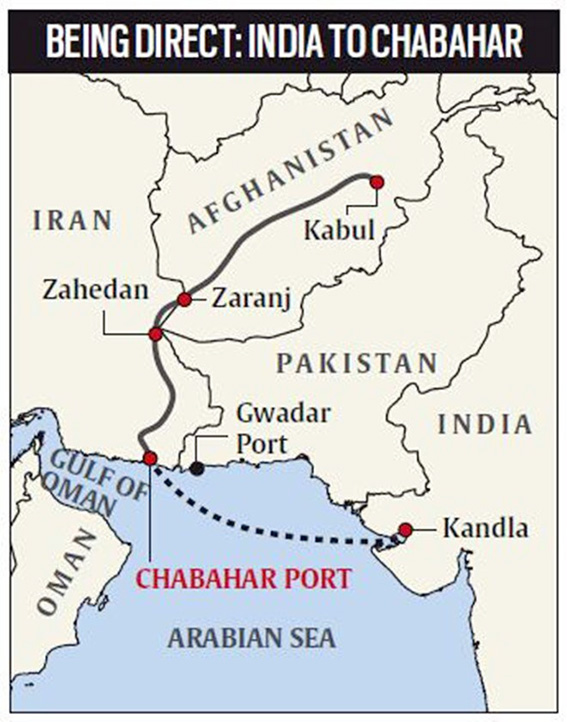
- For India:
- Connectivity:
- It is a key part of India’s plans to enhance connectivity to Afghanistan and the Central Asian states.
- Countering China and Pakistan:
- It opens up a permanent alternative route for trade with Afghanistan and Central Asia, given the hurdles in the direct route through Pakistan.
- China and Pakistan are striving to increase their economic and trade cooperation through the China Pakistan Economic Corridor (CPEC) and Gwadar port, which both are part of China’s Belt and Road Initiative (BRI).
- Part of Indo-Pacific Strategy: Chabahar Port is a key element in India's Indo-Pacific strategy that also includes Eurasia's connection with the Indian Ocean Region.
- Connectivity:
- For Afghanistan:
- It will facilitate India’s role in Afghanistan’s development through infrastructure and education projects and also allow Afghanistan to have a commercial fleet under the Afghan flag sailing from Chabahar.
- For Central Asian Countries:
- Central Asian countries like– Uzbekistan and Kazakhstan– also view Chabahar Port as their gateway to the Indian Ocean Region.
- For India:
- Location:
- International North-South Transport Corridor (INSTC):
- It is a multi-modal transportation established on 12th September 2000 in St. Petersburg, by Iran, Russia and India for the purpose of promoting transportation cooperation among the Member States.
- The INSTC was expanded to include eleven new members, namely: the Republic of Azerbaijan, Republic of Armenia, Republic of Kazakhstan, Kyrgyz Republic, Republic of Tajikistan, Republic of Turkey, Republic of Ukraine, Republic of Belarus, Oman, Syria, Bulgaria (Observer).
- It envisions a 7,200-km-long multi-mode network of ship, rail and road route for transporting freight, aimed at reducing the carriage cost between India and Russia by about 30% and bringing down the transit time from 40 days by more than half.
- This corridor connects India Ocean and the Persian Gulf to the Caspian Sea via the Islamic Republic of Iran and then is connected to St. Petersburg and North Europe via the Russian Federation.
International Relations
India in Afghan Peace Process
Why in News
Recently, the USA President has envisaged a New Peace Initiative (Plan) to decide on the roadmap for peace in Afghanistan.
- Under the plan, the USA proposed a regional conference under the United Nations auspices with foreign ministers of the USA, India, Russia, China, Pakistan and Iran to discuss a “unified approach” on Afghanistan.
Key Points
- USA President’s New Peace Initiative:
- Delay in Withdrawal of Troops: This peace plan has kept open the possibility that the USA troops, currently deployed in Afghanistan, might stay on for a longer time.
- Under the earlier USA- Taliban Deal, the USA had promised to withdraw all troops by May, 2021.
- Immediate Action: The USA is pressing the Taliban to accept an immediate agreement to reduce violence for 90 days that will provide the space for the peace initiative.
- Inclusive Process: The USA will not be “dictating terms” to the Afghan parties, but facilitating an inclusive interim government, an agreement on the “foundational principles” for a new political order, and a “permanent and comprehensive ceasefire”.
- Turkey’s Role: The USA is asking Turkey to convene a meeting of the government in Kabul (capital of Afghanistan) and the Taliban to finalise a peace settlement.
- Unified Approach: The USA asked the United Nations to convene a meeting of the foreign ministers from China, Russia, Pakistan, Iran, India and the United States to develop a “unified approach” to peace in Afghanistan.
- Delay in Withdrawal of Troops: This peace plan has kept open the possibility that the USA troops, currently deployed in Afghanistan, might stay on for a longer time.
- India’s Role in Peace Process Through “Unified Approach”:
- India is an important player in the peace process – it has also been acknowledged by the USA.
- India supports all efforts for peace and reconciliation in Afghanistan which are inclusive and Afghan-led, Afghanowned and Afghan-controlled.
- India has invested heavily in infrastructure developments, training security forces and supplying them with necessary equipment.
- India has a major stake in the stability of Afghanistan since it has invested considerable resources in Afghanistan's development.
- India hopes to have a role in setting the terms especially concerning terrorism, violence, women’s rights and democratic values.
- India’s Interest in Afghanistan:
- Economic and Strategic Interest: Afghanistan is a gateway to the oil and mineral-rich Central Asian republics.
- Anyone who is in power in Afghanistan controls the land routes connecting India with Central Asia (via Afghanistan).
- Developmental Projects: The massive reconstruction plans for the country to offer a lot of opportunities for Indian companies.
- Major projects include the Afghan Parliament, the Zaranj-Delaram Highway, and the Afghanistan-India Friendship Dam (Salma Dam).
- Also India’s assistance of more than USD 3 billion in projects, hundreds of small development projects (of schools, hospitals and water projects) have cemented its position in Afghanistan.
- Security Interest: India has been the victim of state-sponsored terrorism emanating from Pakistan supported terrorist group operating in the region (e,g. Haqqani network). Thus, setting up a friendly government in Afghanistan can help tackling Pakistan supported terrorism.
- Economic and Strategic Interest: Afghanistan is a gateway to the oil and mineral-rich Central Asian republics.
- Challenges:
- The Afghan government as well as Taliban are unwilling for any power sharing.
- Taliban is even not willing to give up its sanctuaries in Pakistan. Nor will it accept any dilution of the strict Islamic system that it wants to enforce.
- Also, the Taliban is fragmented or divided internally. It is composed of various regional and tribal groups acting semi-autonomously.
- Therefore, it is possible that some of them may continue to engage in violence impacting the peace process and dialogue.
- The Afghan government as well as Taliban are unwilling for any power sharing.
Way Forward
- An independent, sovereign, democratic, pluralistic and inclusive Afghanistan is crucial for peace and stability in the region.
- In order to ensure the same, the Afghan peace process should be Afghan-led, Afghan-owned and Afghan-controlled.
- Also, there is a need for the global community to fight against the global concern of terrorism. In this context, it high time to adopt the Comprehensive Convention on International Terrorism (proposed by India at UN in 1996).
- Though the new initiative by the USA is a good step, the road ahead would not be easy. Achieving lasting peace in Afghanistan will require patience and compromise among all parties.
Social Justice
State of Water Supply in Schools and Anganwadis
Why in News
According to information provided to the Parliamentary Standing Committee on Water Resources, only half of government schools and anganwadis have tap water supply, despite a 100-day campaign for 100% coverage being launched by the Jal Shakti Ministry in October 2020.
- The Committee also noted the progress of the flagship Jal Jeevan Mission.
Key Points
- About the Campaign:
- The campaign aims to provide potable piped water supply for drinking and cooking purposes and tap water for hand washing and in toilets in every school, anganwadi and ashramshala or residential tribal school.
- It was launched on 2nd October, 2020 (Gandhi Jayanti).
- The 100-day period should have ended on 10th January, 2021.
- However, some States/ UTs have indicated that they need more time to complete the task and sustain the efforts. Therefore, the campaign has been extended till 31st March, 2021.
- Related Observations:
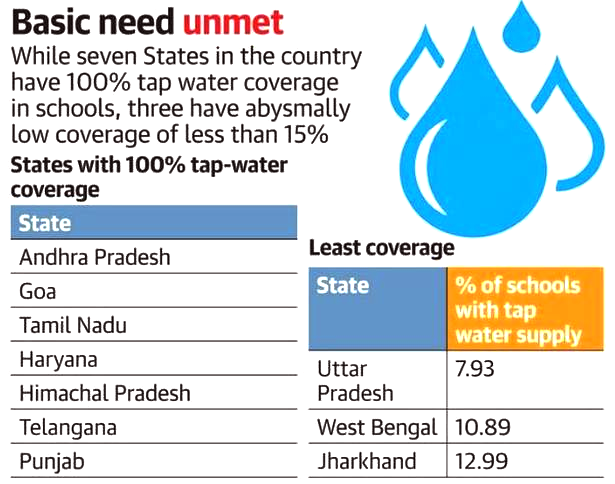
- As of now, only 48.5% of anganwadis and 53.3% of schools had tap water supply.
- Less than 8% of schools in Uttar Pradesh and 11% in West Bengal have it, while it is available in only 2-6% of anganwadis in Assam, Jharkhand, U.P., Chhattisgarh and Bengal.
- Seven States - Andhra Pradesh, Goa, Haryana, Himachal Pradesh, Tamil Nadu, Telangana and Punjab - achieved 100% coverage.
- Around 1.82 lakh grey water management structures and 1.42 lakh rainwater harvesting structures were also constructed in schools and anganwadi centres.
- Health Issues of Children Emanating from Contaminated Water:
- Children are more susceptible to water borne diseases (Diarrhea, Cholera, Typhoid), more so, when there is also a need for repeated washing of hands as a precautionary measure during the pandemic.
- Other nutritional issues and the health hazards emerge in children from on account of lack of potable drinking water.
- About Jal Jeevan Mission:
- Jal Jeevan Mission (JJM) envisages supply of 55 litres of water per person per day to every rural household through Functional Household Tap Connections (FHTC) by 2024.
- JJM focuses on integrated demand and supply-side management of water at the local level.
- Creation of local infrastructure for source sustainability measures as mandatory elements, like rainwater harvesting, groundwater recharge and management of household wastewater for reuse, would be undertaken in convergence with other government programmes/schemes.
- The Mission is based on a community approach to water and includes extensive Information, Education and Communication as a key component of the mission.
- JJM looks to create a jan andolan for water, thereby making it everyone’s priority.
- Funding Pattern: The fund sharing pattern between the Centre and states is 90:10 for Himalayan and North-Eastern States, 50:50 for other states, and 100% for Union Territories.
- In the Budget 2021-22, Jal Jeevan Mission (Urban) has been announced under the Housing and Urban Affairs Ministry to provide universal coverage of water supply to all households through functional taps in all statutory towns in accordance with Sustainable Development Goal- 6.
- Suggestions:
- The Standing Committee noted that mere provision of tap connection without ensuring assured availability of water in the pipeline would not serve the purpose and would defeat the very objective of JJM.
- It called for real-time monitoring of water supply at the district level.
- The centre government should take measures to set up water purification or reverse osmosis (RO) plants on an urgent basis so that children do not suffer due to contamination of drinking water.
Grey water
- Grey water is defined as wastewater that is produced from household processes (e.g. washing dishes, laundry and bathing).
- Grey water can contain harmful bacteria and even faecal matter that contaminates soil and groundwater.
Science & Technology
Most Distant Quasar P172+18
Why in News
Recently, an international team of astronomers has discovered the most distant ‘Radio-Loud’ Quasar with the help of European Southern Observatory’s Very Large Telescope (ESO’s VLT).
Key Points
- Quasars:
- Quasars are very luminous objects in faraway galaxies that emit jets at radio frequencies.
- The word quasar is short for "quasi-stellar radio source".
- The name, which means star-like emitters of radio waves, was given in the 1960s when quasars were first detected.
- The name is retained today, even though astronomers now know most quasars are faint radio emitters. In addition to radio waves and visible light, quasars also emit ultraviolet rays, infrared waves, X-rays, and gamma-rays.
- Most quasars are larger than our solar system. A quasar is approximately 1 kiloparsec in width.
- They are only found in galaxies that have supermassive blackholes which power these bright discs.
- Most active galaxies have a supermassive black hole at the centre which sucks in surrounding objects.
- Quasars are formed by the energy emitted by materials swirling around a blackhole right before being sucked into it.
- They are further categorised into the "radio-loud" and the "radio-quiet" classes.
- Radio-loud:
- They are with powerful jets that are strong sources of radio-wavelength emission.
- These make up about 10% of the overall quasar population.
- Radio-quiet :
- They are those quasars lacking powerful jets, with relatively weaker radio emission than the radio-loud population.
- The majority of quasars (about 90%) are radio-quiet.
- Radio-loud:
- Recently Discovered Quasar/P172+18:
- Named P172+18, the quasar emitted wavelengths which had a redshift of 6.8.
- It took 13 billion years for the quasar’s light to reach earth.
- This particular quasar appears to the scientists as it was when the universe was just around 780 million years old.
- The glowing disc around a blackhole is 300 million times more massive than our Sun.
- It is also one of the fastest accreting quasars, which means it is accumulating objects from the galaxy at an enormous speed.
- Only three other ‘radio-loud’ sources with redshift greater than six have been discovered so far and the most distant one had a redshift of 6.18.
- The higher the redshift of the radio wavelength, the farther away is the source.
- Named P172+18, the quasar emitted wavelengths which had a redshift of 6.8.
- Inference:
- The blackhole at its centre is consuming from its galaxy at a stunning rate.
- Significance:
- A detailed study of these ‘radio-loud’ super bright objects can lead astronomers to understanding how the supermassive blackholes in their core grew to be as big so rapidly since the Big Bang.
- It also holds clues about the ancient star systems and astronomical bodies.
- About the ESO’s VLT:
- The Very Large Telescope used to observe the P172+18 is located at Paranal Observatory in the Atacama Desert.
- The four Unit Telescopes boast 8.2-meter (27 feet) mirrors.
- Just one of these instruments can spot objects that are 4 billion times fainter than what can be seen with the unaided eye.
- According to the European Southern Observatory, the Very Large Telescope is the world's most advanced optical telescope.
- The Very Large Telescope used to observe the P172+18 is located at Paranal Observatory in the Atacama Desert.
Redshift
- Gravitational redshift occurs as particles of light (photons) climb out of a gravitational well like a black hole and the light's wavelength gets drawn out. This shifts the wavelength to the red part of the light spectrum - hence "redshift".
- In order to escape intense gravity, particles of light (photons) must expend energy.
- However, at the same time, these photons must travel at a constant speed - the speed of light.
- Therefore, the photons can't lose energy by slowing down but must expend it in another way.
- This lost energy manifests itself as a shift towards the red end of the light spectrum.
Economy
Pre-Pack Insolvency Resolution Process
Why in News
Recently, a sub-committee of the Insolvency Law Committee (ILC) has recommended a pre-pack framework within the basic structure of the Insolvency and Bankruptcy Code (IBC), 2016.
- The Government had constituted a sub-committee of Insolvency Law Committee (ILC) in June, 2020 under the chairmanship of Dr. M. S. Sahoo, Chairperson, Insolvency and Bankruptcy Board of India (IBBI) to make recommendation on Pre-Pack Insolvency Resolution Process (PPIRP).
Key Points
- Pre-Packs:
- A pre-pack is an agreement for the resolution of the debt of a distressed company through an agreement between secured creditors and investors instead of a public bidding process.
- This system of insolvency proceedings has become an increasingly popular mechanism for insolvency resolution in the UK and Europe over the past decade.
- In India’s case, such a system would likely require that financial creditors agree on terms with potential investors and seek approval of the resolution plan from the National Company Law Tribunal (NCLT).
- A pre-pack is an agreement for the resolution of the debt of a distressed company through an agreement between secured creditors and investors instead of a public bidding process.
- Need for Pre-Packs:
- Slow progress in the resolution of distressed companies has been one of the key issues raised by creditors regarding the Corporate Insolvency Resolution Process (CIRP) under the IBC.
- CIRP is the process of resolving the corporate insolvency of a corporate debtor in accordance with the provisions of the Code.
- Under the IBC, stakeholders are required to complete the CIRP within 330 days of the initiation of insolvency proceedings.
- Slow progress in the resolution of distressed companies has been one of the key issues raised by creditors regarding the Corporate Insolvency Resolution Process (CIRP) under the IBC.
- Key Features of Pre-Packs:
- Pre-Pack usually requires services of an insolvency practitioner to assist the stakeholders in the conduct of the process.
- The extent of authority of the practitioner varies across jurisdictions.
- Pre-pack envisages a consensual process - prior understanding among or approval by stakeholders about the course of action to address stress of a Corporate Debtor (CD), before invoking the formal part of the process.
- No requirement of Court Approval: It does not always require approval of a court. Wherever it requires approval, the courts often get guided by commercial wisdom of the parties.
- Outcome of the pre-pack process, where approved by the court, is binding on all stakeholders.
- Pre-Pack usually requires services of an insolvency practitioner to assist the stakeholders in the conduct of the process.
- Advantages of Pre-pack Offer:
- Quick Resolution: Pre-pack, which enables a faster resolution, preserves and maximises value (of a company in a stressful state) and increases the possibility of resolution.
- Minimises Disruptions to the Business: Since the CD continues with the existing management during pre-pack, it avoids the cost of disruption of business as it does not shift management to Interim Resolution Professional (i.e. unlike that in the CIRP process) and continues to retain employees, suppliers, customers, and investors.
- Group Resolution: Given that resolution of a group of companies can be value-adding as compared to a separate insolvency proceeding for each company in distress, many jurisdictions are contemplating to make available an enabling framework for the same.
- In the absence of any mechanism to effectively deal with insolvency of a group of companies in most jurisdictions, pre-packs have proved to be very helpful.
- Lighter on Courts: The courts usually have limited infrastructural capacity and can perform its obligations within its limits.
- A pre-pack has the potential to reduce litigation, due to its informal and consensual nature. It does not require involvement of the court during the informal part of the process and requires a minimum role of courts during formal process.
- It is necessary to have a functional out of court restructuring process, so that the vast majority of cases are restructured out of bankruptcy, with the NCLT acting as a court of last resort if no agreement is possible.
- Drawbacks of Pre-Packs:
- Lack Transparency:
- The key drawback of a pre-packaged insolvency resolution is the reduced transparency compared to the CIRP as financial creditors would reach an agreement with a potential investor privately and not through an open bidding process.
- This could lead to stakeholders such as operational creditors raising issues of fair treatment when financial creditors reach agreements to reduce the liabilities of the distressed company.
- Insufficient Marketing: The research shows that where no marketing is carried out pre-packs return less money to creditors.
- No consideration is given to the future viability of the new company: The insolvency practitioner has no legal requirement to look at the future viability of the new business emerging from a pre-pack sale.
- His/her only legal responsibility is to the creditors of the old business.
- Lack Transparency:
Way Forward
- Under the present regime of the IBC, insolvency professionals are still evolving the necessary expertise required over time. Like the law under the UK regime has evolved over time rather than simply promulgated, application of pre-pack insolvency in India will require a much higher degree of expertise of insolvency professionals, as under such resolution methods, they have a much higher degree of control.
- However, with the increase in the trend of out of court settlements, pre-pack insolvency could very well be the next alternative to regular CIRP proceedings.
Indian Economy
PLI Scheme for Telecom Sector
Why in News
The Union Cabinet has approved the Production-Linked Incentive (PLI) scheme for the telecom sector with an outlay of Rs. 12,195 crores over five years.
Key Points
- About the PLI Scheme:
- In order to boost domestic manufacturing and cut down on import bills, the central government in March 2020 introduced a scheme that aims to give companies incentives on incremental sales from products manufactured in domestic units.
- Apart from inviting foreign companies to set shop in India, the scheme also aims to encourage local companies to set up or expand existing manufacturing units.
- The Scheme has been approved for many sectors including electronic products, IT hardware, pharmaceuticals, automobiles and components, etc.
- PLI Scheme for Telecom Sector :
- About:
- This Scheme is for domestic manufacturing of telecom and networking products such as switches, routers, 4G/5G radio access network, wireless equipment and other internet of things (IoT) access devices.
- It will be operational from 1st April, 2021.
- Eligibility for the Scheme:
- It is subject to achieving a minimum threshold of cumulative incremental investment and incremental sales of manufactured goods.
- The cumulative investment can be made at one go, subject to annual cumulative threshold as prescribed for four years being met.
- 2019-20 will be treated as the base year for computation of cumulative incremental sales of manufactured goods net of taxes.
- Incentives:
- An investor who qualifies for the scheme will be incentivised up to 20 times the minimum investment threshold, enabling them to utilise their unused capacity.
- Higher Incentives for MSMEs:
- For Micro, Small and Medium Enterprises (MSMEs), the minimum investment threshold has been kept at Rs. 10 crore, while for others it is Rs. 100 crore.
- For MSMEs, a 1% higher incentive is also proposed in the first three years.
- About:
- Significance :
- The scheme is expected to lead to an incremental production of about Rs. 2.4 lakh crore, with exports of about Rs. 2 lakh crore over five years and bring in investments of more than Rs. 3,000 crore.
- Scheme is also likely to generate 40,000 direct and indirect employment opportunities and generate tax revenue of Rs. 17,000 crore from telecom equipment manufacturing.
- Through this scheme, India will move towards self-reliance. Currently, India imports over 80% of its telecom and wireless networking equipment.
Indian Economy
New Umbrella Entity for Payment Systems
Why in News
The private companies have shown interest in setting up New Umbrella Entities (NUEs) for payment systems - an idea floated by the Reserve Bank of India (RBI).
- The aim is to create an alternate mechanism to the existing National Payments Corporation of India (NPCI).
Key Points
- New Umbrella Entities (NUEs):
- About: NUEs will be a non-profit entity that will set-up, manage and operate new payment systems, especially in the retail space such as ATMs, white-label PoS; Aadhaar-based payments and remittance services.
- Functions Envisaged:
- NUEs will develop new payment methods, standards and technologies.
- These will operate clearing and settlement systems, identify and manage relevant risks such as settlement, credit, liquidity and operation and preserve the integrity of the system.
- These will monitor retail payment system developments and related issues in the country and internationally to avoid shocks, frauds and contagions that may adversely affect the system and the economy in general.
- Need for NUEs:
- Limitations of NPCI: Currently, the umbrella entity for providing retail payments system is NPCI, which is a non-profit entity, owned by banks.
- To Increase Competitiveness: RBI’s plan to allow other organisations to set up umbrella entities for payments systems aims to expand the competitive landscape in this area.
- Players planning to establish these NUE aim to get an even bigger share in the digital payments sector.
- Limitations of NPCI: Currently, the umbrella entity for providing retail payments system is NPCI, which is a non-profit entity, owned by banks.
- Framework Related to NUEs:
- Owned and Controlled by Residents: The promoter or the promoter group for the NUE should be ‘owned and controlled by residents’ with 3 years’ experience in the payments ecosystem.
- The shareholding pattern should be diversified. Any entity holding more than 25% of the paid-up capital of the NUE will be deemed to be a promoter.
- Capital: The umbrella entity shall have a minimum paid-up capital of Rs. 500 crore.
- No single promoter or promoter group should have more than 40% investment in the capital of the entity.
- A minimum net worth of Rs. 300 crore should be maintained at all times.
- Governance Structure: The NUE should conform to the norms of corporate governance along with ‘fit and proper’ criteria for persons to be appointed on its board.
- The RBI retains the right to approve the appointment of directors as also to nominate a member on the board of the NUE.
- Foreign Investment: Allowed in NUEs as long as they comply with the existing guidelines.
- Owned and Controlled by Residents: The promoter or the promoter group for the NUE should be ‘owned and controlled by residents’ with 3 years’ experience in the payments ecosystem.
Important Facts For Prelims
Janaushadhi Diwas
Why in News
The Bureau of Pharma PSUs of India (BPPI) celebrated the 3rd Janaushadhi Diwas (7th March 2021) to spread awareness about quality generic medicines, available at low prices.
- Theme of Janaushadhi Diwas was “Seva Bhi – Rozgar bhi”. The Janaushadhi week was celebrated across the country from 1st-7th March 2021.
- As a part of celebrations, the Prime Minister inaugurated the 7,500th Janaushadhi Kendra at NEIGRIHMS, Shillong.
Key Points
- Janaushadhi Kendra:
- Bureau of Pharma PSUs in India (BPPI) supports Janaushadhi Kendras as a part of Pradhan Mantri Bhartiya Janaushadhi Pariyojana.
- These are the centres from where quality generic medicines are made available to all.
- The number of stores has grown to more than 7400 and all 734 districts of the country have Janaushadhi Kendras.
- Government grants of up to Rs. 2.5 lakhs are provided for setting up of Pradhan Mantri Janaushadhi Kendras, which can be set up by doctors, pharmacists, entrepreneurs, Self Help Groups (SHGs), NGOs, charitable societies, etc. at any suitable place or outside the hospital premises.
- Pradhan Mantri Bhartiya Janaushadhi Pariyojana (PMBJP):
- PMBJP is a campaign launched by the Department of Pharmaceuticals in 2008 under the name Jan Aushadhi Campaign.
- The campaign was revamped as PMBJP in 2015-16.
- Bureau of Pharma PSUs of India (BPPI) is the implementation agency for PMBJP.
- The Bureau of Pharma PSUs of India works under the Ministry of Chemicals & Fertilizers.
- BPPI has also developed the Janaushadhi Sugam Application.
- PMBJP stores have been set up to provide generic drugs, which are available at lesser prices but are equivalent in quality and efficacy as expensive branded drugs.
- It also intends to extend the coverage of quality generic medicines so as to reduce the out of pocket expenditure on medicines and thereby redefine the unit cost of treatment per person.
- A medicine under PMBJP is priced on the principle of a maximum of 50% of the average price of top three branded medicines. Therefore, the price of Janaushadhi Medicines is cheaper at least by 50% and in some cases, by 90% of the market price of branded medicines.
- PMBJP is a campaign launched by the Department of Pharmaceuticals in 2008 under the name Jan Aushadhi Campaign.
- Performance Analysis:
- In the current financial year 2020-21, PMBJP has already achieved sales of Rs. 593.84 crores. This has led to savings of approximately Rs. 3600 crores of the common citizens of the country.
- This scheme is also providing a good source of self-employment with sustainable and regular earnings.
Important Facts For Prelims
Defence Acquisition Council’s Plans
Why in News
Multi billion deals for armed drones from the USA and advanced submarines under Project-75I are to be taken by the Defence Acquisition Council (DAC).
Key Points
- India - USA Drone Deals:
- India has been looking to procure 30 armed drones, 10 for each service, from the USA but the process has been repeatedly delayed over the last couple of years.
- The USA has given in principle approval for the sale of these armed drones to India during the India-US 2+2 ministerial dialogue.
- While the Navy has a pressing requirement for the High Altitude Long Endurance (HALE) drones, there have been questions on their utility for the Army and Air Force, given the high cost of the platform.
- Since the stand-off with China in Eastern Ladakh in May 2020, the need for long endurance drones to maintain continuous surveillance of the border has been acutely felt.
- The Navy has already inducted two MQ-9B Sea Guardian unarmed drones procured from the USA.
- India has been looking to procure 30 armed drones, 10 for each service, from the USA but the process has been repeatedly delayed over the last couple of years.
- Project-75I:
- The Project 75I-class submarine is a follow-on of the Project 75 Kalvari-class submarine for the Indian Navy.
- The project is being processed through the Strategic Partnership (SP) model of the Defence Procurement Procedure (DPP).
- The strategic partnership model seeks to identify a few Indian private companies as Strategic Partners who would initially tie up with a few shortlisted foreign Original Equipment Manufacturers (OEMs) to manufacture big-ticket military platforms.
- It aims to promote the role of Indian industry in defence manufacturing and build a domestic defence industrial ecosystem.
- This project is part of the 30 year Plan for indigenous submarine construction and it got its approval by the Cabinet Committee on Security in 1999.
- The idea behind this was to help in streamlining the submarine acquisition process and creating two submarine production lines where the plan was to construct six submarines on each.
Defence Acquisition Council
- The Defence Acquisition Council (DAC) is the highest decision-making body in the Defence Ministry for deciding on new policies and capital acquisitions for the three services (Army, Navy and Air Force) and the Indian Coast Guard.
- The Minister of Defence is the Chairman of the Council.
- It was formed, after the Group of Ministers recommendations on 'Reforming the National Security System', in 2001, post Kargil War (1999).

